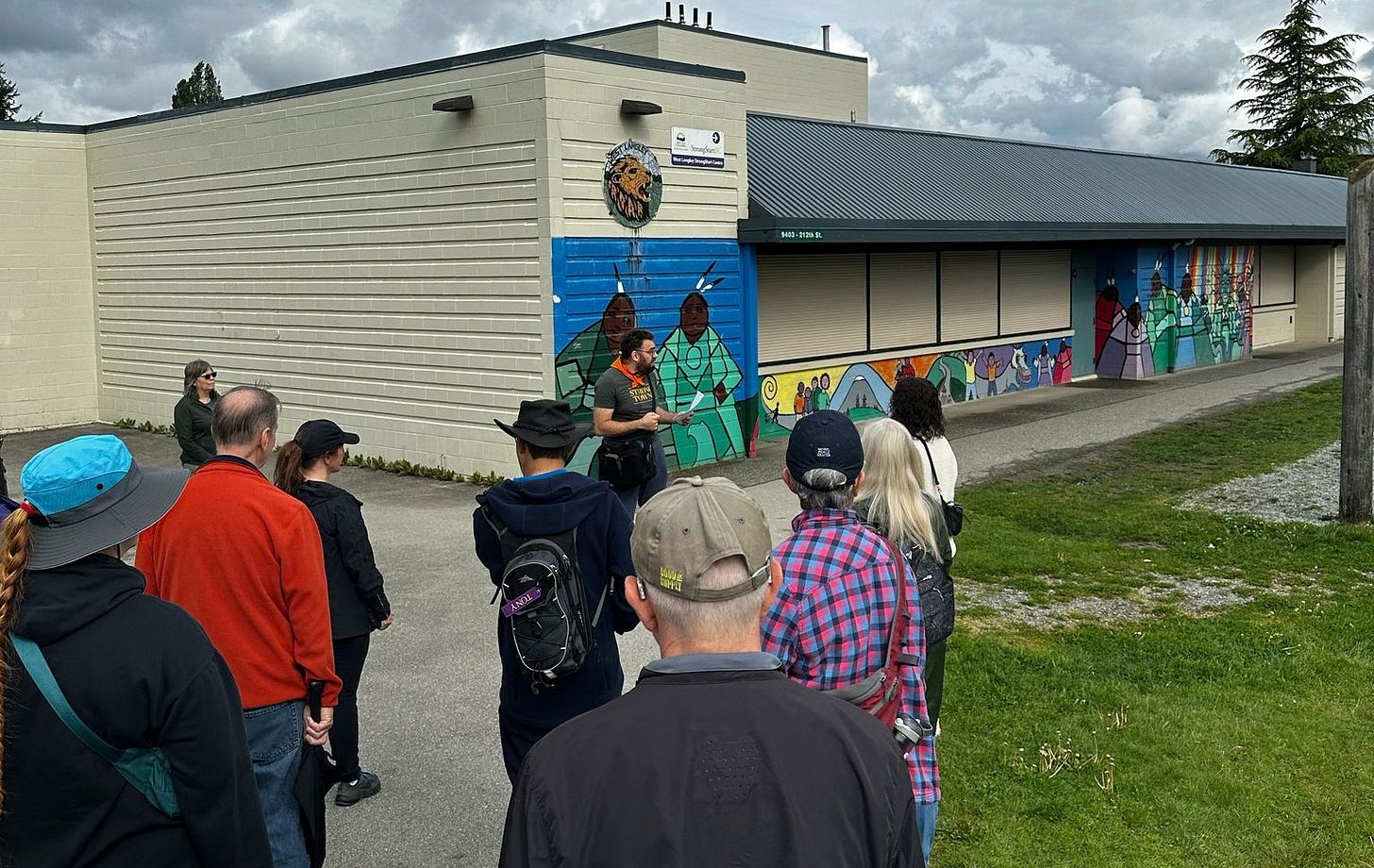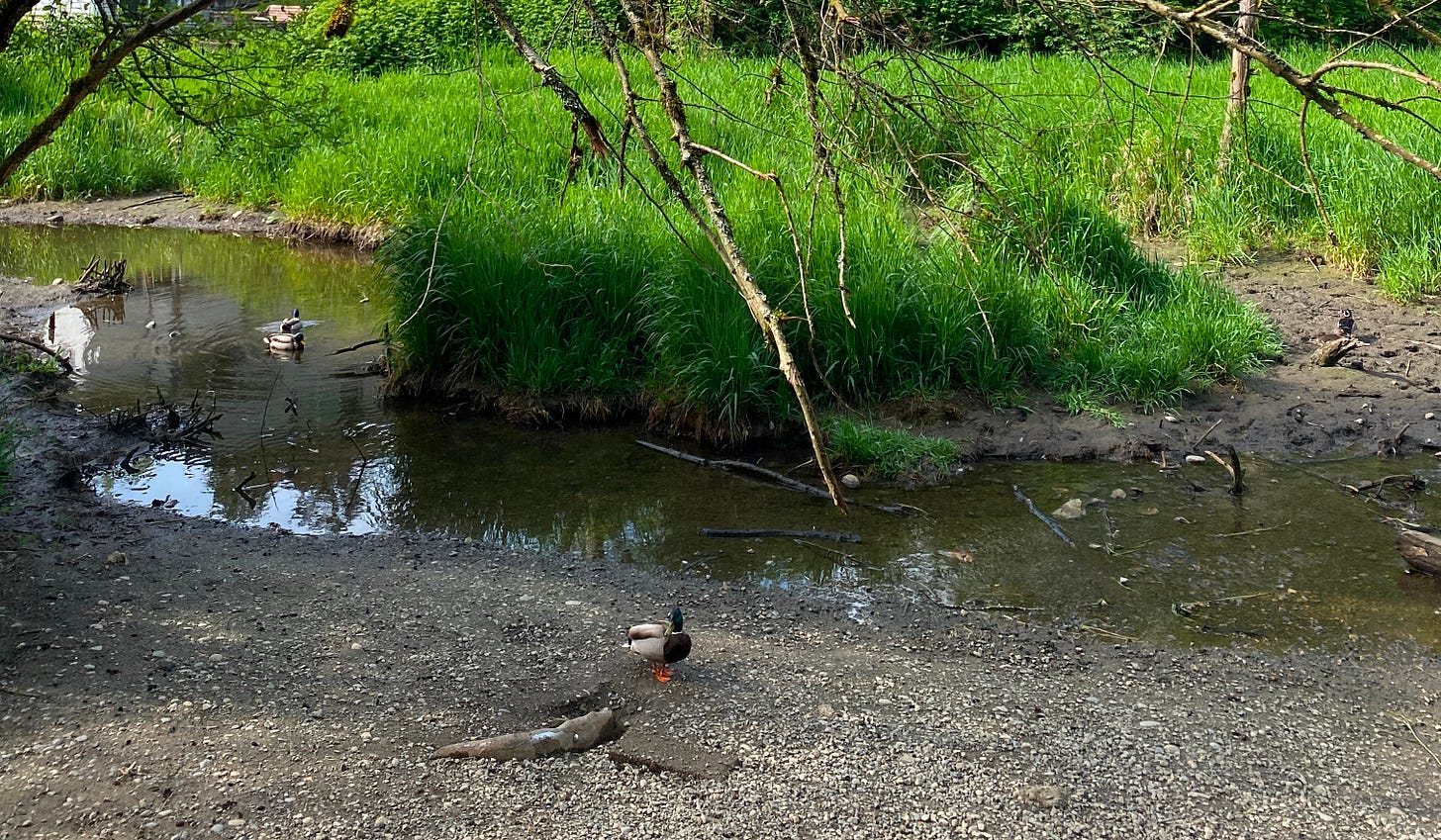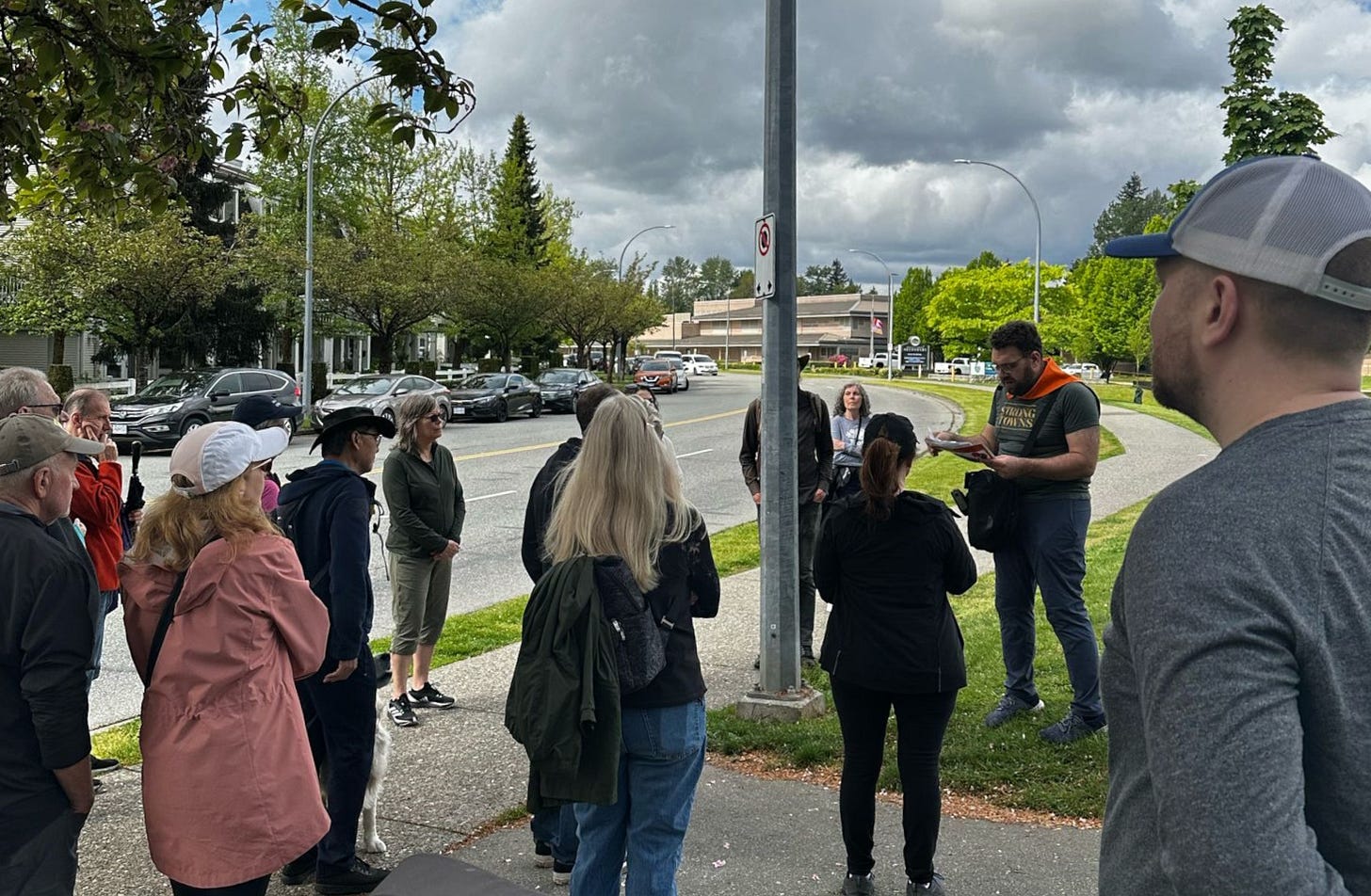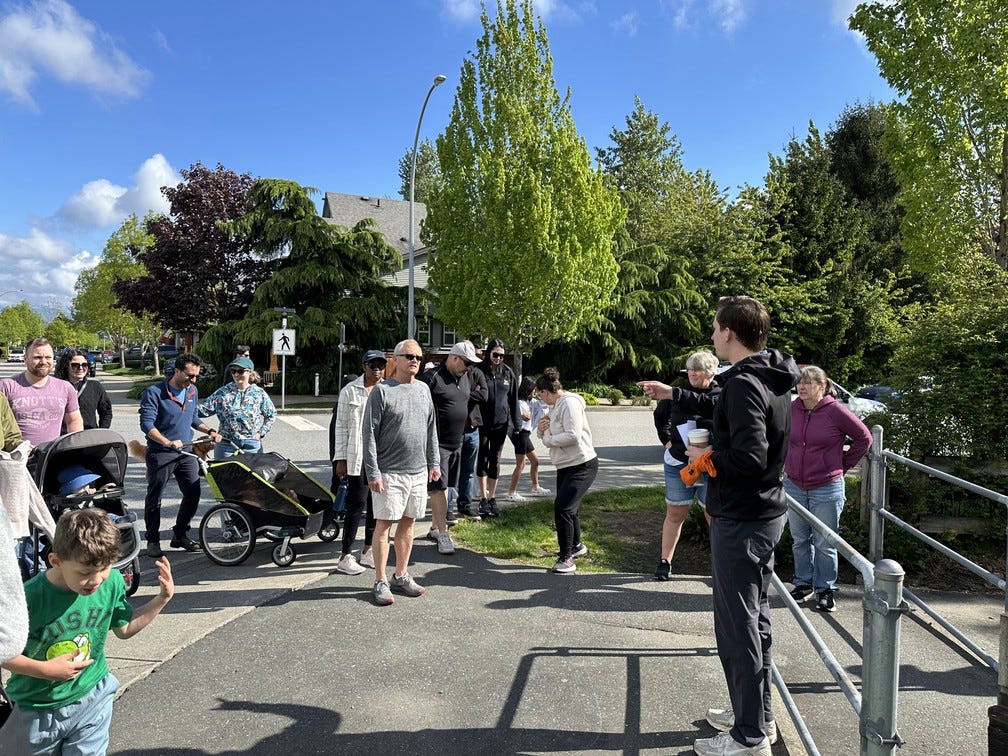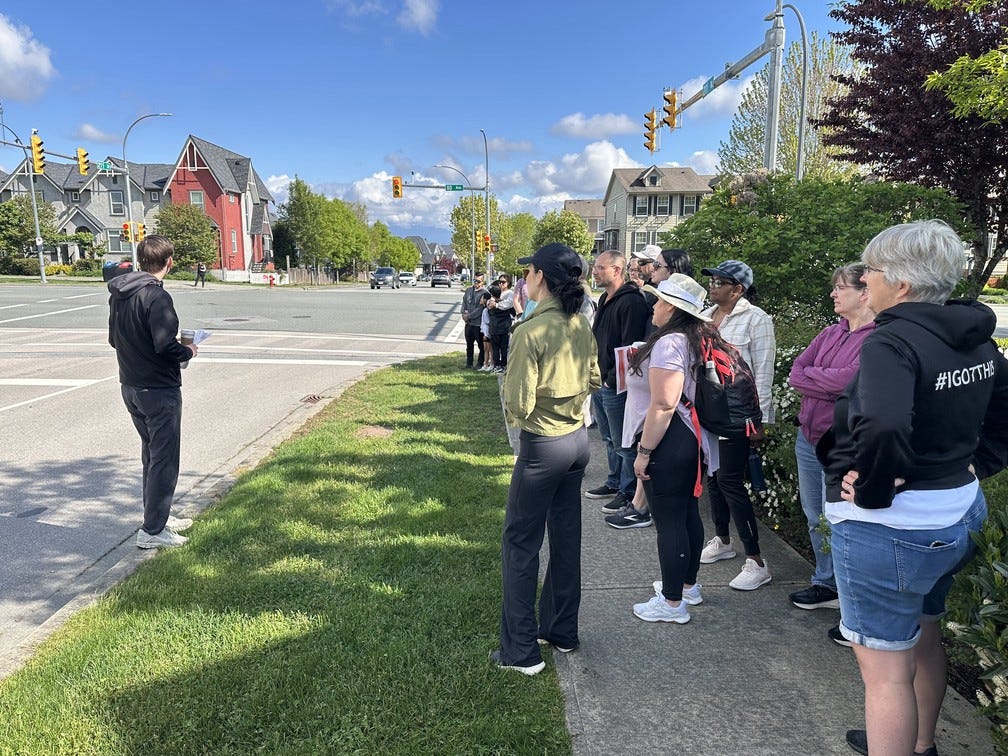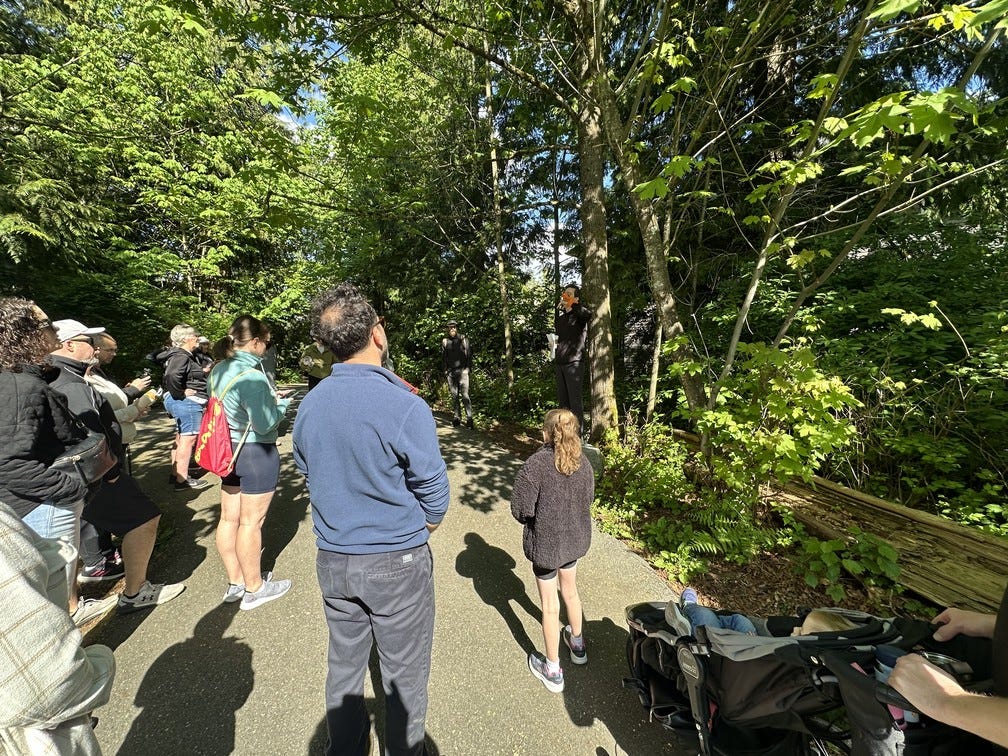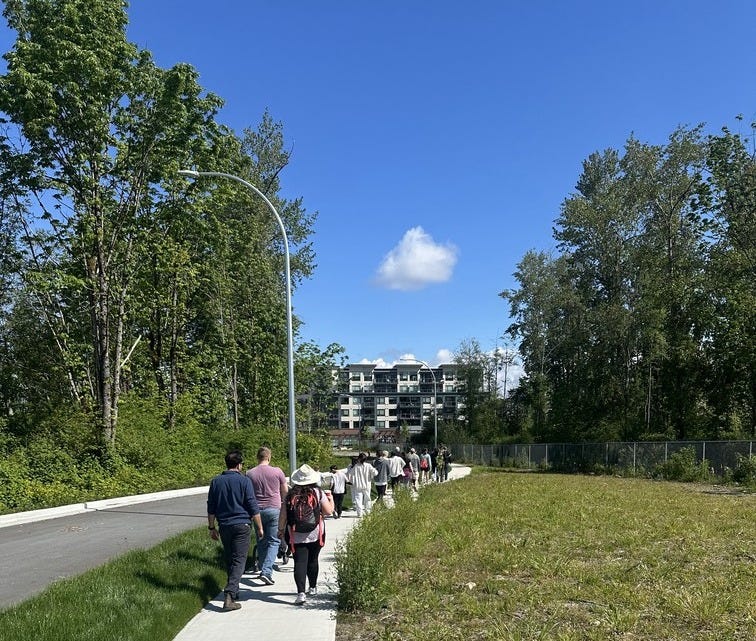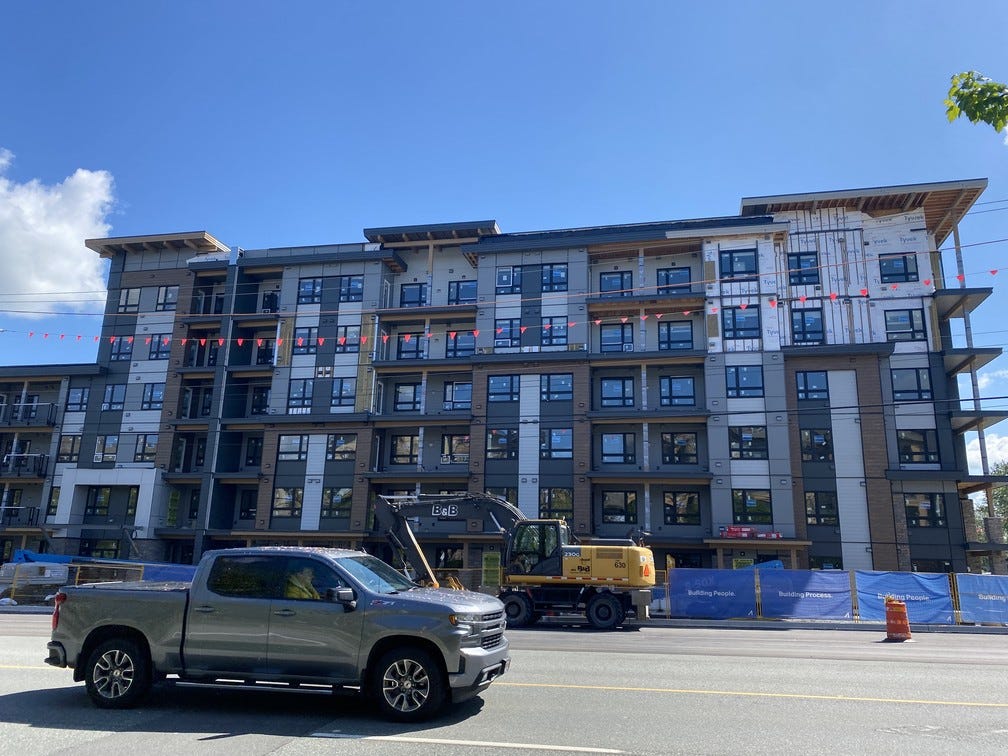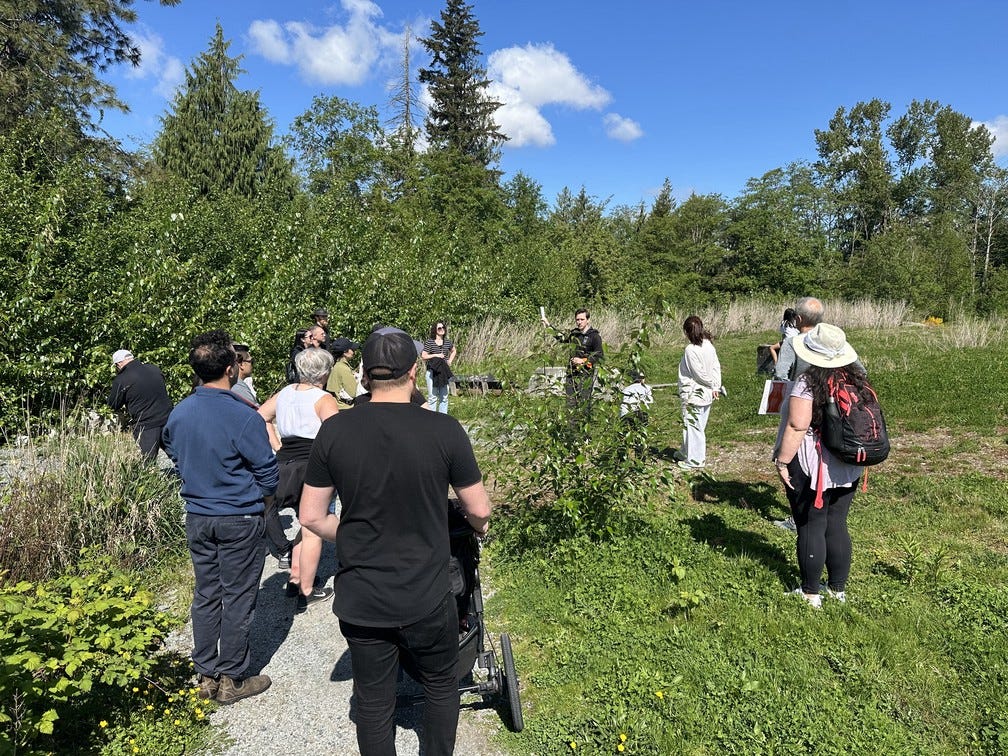This past weekend, we hosted two Jane’s Walks in Langley, the first on Saturday in Walnut Grove starting at West Langley Park, followed by another on Sunday in Willoughby starting at Lynn Fripps.
Approximately 15-20 people showed up for both walks, which was really encouraging. It’s great to see so many people were able to come, and I deeply appreciated everyone who was willing to give up an entire morning of their free time to attend! Both walks also completed on schedule, with the Walnut Grove walk ending around 11:15am, and the Willoughby walk taking a bit longer ending just before 11:30am. Everyone did well keeping up the pace!
Walnut Grove
As the leader of this walk, and I really wanted to highlight Walnut Grove’s excellent trail system and use that as much as possible to complete the loop. In the Walnut Grove Official Community Plan, it states the following:
Community Pattern
…d. The linking of educational areas, active park areas, and conservation areas through the provision of pedestrian trail systems.
In my view this integration with schools and pedestrian trails is most clearly shown at West Langley Elementary school, which, as I pointed out on the walk, is placed right on the Langley Lane Greenway, and does not have any arterial road access, making it safer and nicer for children to walk to school. It is people-first thinking, rather than worrying about how a fleet of children in cars will get there.
We continued along the greenway, to arrive at the duck pond along East Munday creek. I noted how despite my research I couldn’t determine where West Munday and East Munday creek got their names, but speculated it might be named after George Munday, a prominent figure in early colonial history of the region and who Mundy Park in Coquitlam is named for.
I also took a little detour to highlight one of my favourite little oddities in Walnut Grove, which is a 3-way intersection of alleyways next to the Duck Pond. I commented how areas like this are great for unstructured play for kids, it’s not a playground or a park, but it’s a safe public space away from traffic.
Next we arrived at Holmstead Park, where I took a moment to highlight how Walnut Grove is peppered with all these nice little parks that add so much greenspace to the community. I also mentioned how this area of Walnut Grove had been hit pretty hard during the 1980s recession. When I was doing research about Walnut Grove was impacted a while ago on Facebook, Cec Walk shared how “When we moved to 213th street in 1984, south of 92 B was a block of basements poured and left when the market downturned.” and I shared this story with the group.
I also shared something Kurt Alberts, former mayor and planner for the Township of Langley, who was responsible for planning Walnut Grove, shared with me via email, in that before the recession new vacant lots could be had for $70,000, but after things recovered $69,000 got you a lot and a house! This got some gasps from the group.
After we left the park, I pointed out a recently new house that I thought was a teardown and rebuild, but was corrected in that it was an extremely extensive renovation and expansion. I noted that it had been completed as a single family home, despite it’s huge size, and following the provinces zoning changes allowing multiplexes we may start to see projects like that become multiplex housing. I made note that much of the houses we had walked past were all between $1 million and $1.5 million (at least), and how I hoped this zoning change would bring more affordable housing options to Walnut Grove.
Bringing up some of the history of the recession got some other attendees sharing how they remembered when streets were empty and there were unfinished homes as well. While heading south on 213th Street, one of the attendees, named Rob, told me how when he moved to the area, 213th Street originally went all the way through where the school is now.
I made note that clearly a decision had been made to close this road at the time to not prevent a busy road running next to a school. It’s a great example of a modal filter applied to an existing major road, allowing bikes and people to walk though, but not cars. And this was the mid-1980s! It’s regrettable we don’t see planning in newer parts of the Township able take such firm stances against existing roads today.
We continued through James Kennedy and crossed 93 Ave / 212 St. I made note of the sliplane at the corner and how our group has been campaigning to have sliplanes in Walnut Grove removed as they feel unsafe and hostile to people walking, especially so close to a school. I also mentioned how our group is supporting Alecia Jordan’s campaign to add traffic calming to Walnut Grove Drive.
At the corner of Walnut Grove Community park, I made a couple of Strong Townsy points. The first was that while all the detached houses in Walnut Grove had been constructed in the 1980s, it took until the mid 90s for these townhomes, the Highland Ridge complex, to be completed. This is an example of incrementalism in neighbourhood growth - once Walnut Grove was starting to see real success and growth in residents moving in, developers were more comfortable to make bigger bets on the community in the form of denser types of housing at a larger scale.
My second point was on Walnut Grove Town Centre, although our walking tour didn’t go through there (maybe next year I will change the route?) - in that it might appear a little old and outdated as a kind of strip mall, this actually gives it an advantage of lower rental rates, meaning we have some interesting small businesses in there that might not otherwise be able to find a place should it be redeveloped, and that I believe it is a real gem in the community that we would lose should it be completely redeveloped at some point. Personally I wouldn’t be opposed to more infill at the town centre, but I think we should be hesitant about complete redevelopment that often strikes these older strip malls.
Finally, we headed through the park to West Munday Creek and the trail that runs along the ravine, and mentioned how this policy got some pushback at the beginning.
Ravines and rivers run through Walnut Grove, and Langley Township took advantage of that fact as the neighbourhood began to grow. As Kurt Alberts recalled, from the very beginning there were plans to place public trails alongside the ravines.
That policy got a little pushback at the beginning – not everyone was happy with a trail running behind their back yard – but the trails quickly became popular. The trail network now extends east of 216 Street and as far west as 196 Street. It runs from Highway One all the way north to the community's outer edge, where determined hikers can connect up with the Golden Ears Bridge's pedestrian/bike paths and cross over into Pitt Meadows.
I mentioned to a couple of the attendees how Brookswood has similar ravines, but in the new neighbourhood plans there aren’t similar plans to adorn them with walkways, which is a shame. This ravine path, and the others like it, really highlight how successful Walnut Grove was at integrating with nature and taking advantage of these natural features to provide enjoyable walkways away from traffic.
The only major shortcoming in Walnut Grove is housing affordability. During the walk, I mentioned how I believe that there needs to be a path for some of the half acre and quarter acre lots that remain in Walnut Grove to be rezoned to allow more townhomes or apartments to be constructed to provide more affordable options. One of the attendees of the walk brought up the large parking lot at the Colossus movie theatre, and thought the idea of doing some infill with apartments or townhouses there would work well.
Overall, despite the plan being over 40 years old at this point, it’s held up and has some really progressive and bold ideas that still result in a great community.
Willoughby
Michael Pratt, Township Councillor and a friend of mine who has supported many of our other initiatives and events, led the Willoughby walk around the Yorkson neighbourhood.
Almost immediately after starting the walk heading towards the McClarty trail, we ran into a set of maze gates also known as baffle gates. These were present on sections of the Walnut Grove walk as well, but here, Michael made a great point about how they are bad for accessibility, blocking wheelchairs and other mobility devices, as well as bicycles with trailers attached. As such the Township will be making sure they are no longer in future developments, and gradually remove the old ones, likely using bollards instead.
Heading south we reached the cross streets of 80 Ave and 211 Street, and Michael took the time to explain how these wide and fast roads like 80 Ave will eventually be completed, with centre landscaped medians and protected bike lanes, which should make them less of a “drag strip”. This is in line with the original Yorkson Neighbourhood Plan design adopted in 2001, though the plan to also add protected bike lanes goes a step further.

At Richard Bulpitt Park, Michael explained how Richard Bulpitt elementary was recently expanded using a modular system by Fort Modular, which results in more school capacity that inside feels just like part of the school, rather than a portable.
It reminded me that during our walk in Walnut Grove, we had traversed a rather large field behind James Kennedy Elementary, which could also be expanded in a similar way to increase school capacity, should Walnut Grove develop further.
The first highlight of the walk was the Perry-Evans trail, which is a really nice nature trail that preserved the original trees in the area. Here, Michael took time to explain how regrettably the end of the trail comes out in misalignment with the intersection at 208 Street, and that discussions are being made with council and staff on how to address it. Adding a crosswalk so close to the existing intersection wasn’t feasible.
During the walk however, I personally didn’t find it too much of problem having to walk the short distance up to the light at 208 Street and 77A Avenue. The issue is more aesthetic than anything else, in that you can see the trail continues at the same point on the other side with no direct route across, so perhaps this could be addressed with some creative landscaping and signage.
Continuing down 77A Avenue we reached the next highlight of the walk, 206 Street near Willoughby Town Centre. This is an extremely creative landscaping project, where the Yorkson Creek actually runs down the centre of the road, separated by two narrow one-way roads. I plan to take the drone out there to get some aerial photos of it soon, but even from the ground it was very appealing to look at, and walk next to, with tall trees emerging from the centre median.
During the walk Michael mentioned some of the trade-offs that have taken place during Willoughby’s development. The first being the grocery store in the Town Centre having no mixed-use, as the community was in too early stages to ask that of developers at the time. The second was the strip-mall on the corner of 80 Ave and 204 Street, where when developers were asked to add mixed use, all they were willing or able to add was a daycare on a second story.
After completing our loop around the western side of the neighbourhood, Michael took some time to mention the new apartment building on 83 Ave and 208 Street.
He explained that development fees were waived in order to support “Second Stage Housing” in this building, which is available to help people escape difficult domestic situations and similar circumstances. I had no idea this was anything more than another apartment building, so it was interesting to learn about this form of social support housing being added to the community.
The downside of this building being under construction meant that there was no safe sidewalk to be able to reach 83 Avenue after crossing 208 Street, so we ended up having to take a detour up to 84 Avenue, before going south again to end up back at Lynn Fripps park. Overall people enjoyed the walk and also were able to get some good questions answered by Michael. There were questions asked about the planned community centre which were addressed, such as the location and whether a library would be included, which although have been shared at open houses, not everyone can make it to these events.
Overall, Willoughby offers greater housing diversity and affordability, but still needs time to mature and address its infrastructure gaps to truly become the vibrant, walkable community envisioned in its planning documents.
Conclusion
Each walk left me with a very different feeling at the end. The Walnut Grove walk was very pleasant, with it’s greenery and trails, and clearly a lot of thought had been put into these things. Mike from our group who attended the walk, remarked how he never realized how well integrated it is with nature. That being said, Walnut Grove’s lack of adaptability continues to cause pressure on home prices. It’s a nice area, but we’re not making it easy enough for more people to live here. While it’s very safe for kids to walk to school, when those same kids grow up, it is unlikely they could find somewhere affordable live in the neighbourhood.
Willoughby on the other hand has been far more successful in delivering these smaller more affordable homes, but that came with significant trade-offs to get them built early on in the development of the neighbourhood. It was quite frustrating to see how much Willoughby struggles to get the “details” right - for example on the Perry-Evans trail we observed a missing ramp on the east exit point and no crosswalk across 209 Street.
That being said, I am hoping for is that an upside of all this rapid development is that Willoughby can maintain a feeling of a more changing, more adaptable place, more so than Walnut Grove.
Hopefully with time these details will be fixed, and I think that will make doing a Willoughby Jane’s Walk each year potentially more fascinating, as these issues are addressed and the neighbourhood continues to evolve, provided these things are actually dealt with. My hope is also that one day, we’ll see Walnut Grove unafraid and able to evolve and mature in a similar way, with the arrival of multiplex homes, and maybe one day more neighbourhood businesses and shops. Both Walnut Grove and Willoughby suffer from a lack of commercial space integrated into neighbourhoods.
What inspired me most wasn't just seeing the strengths and weaknesses of Walnut Grove and Willoughby, but witnessing the enthusiasm from participants to address the issues we observed. As we walked and talked, there were ideas about how we might fix those missing connections in Willoughby or create more housing options in Walnut Grove. Through Strong Towns Langley, we are building a vehicle to transform these observations into meaningful community action. The conversations during these walks reinforced my belief that engaged residents working together can make our neighbourhoods more walkable, affordable, and connected. Both Walnut Grove and Willoughby have important lessons to teach us, and with some community-driven improvements, they can become even better places to live, work, and play.
Strong Towns Langley is a community group dedicated to making Langley, British Columbia a better place. We advocate for incremental development, sustainable transportation solutions, housing accessibility, public spaces, and responsible growth strategies. Our group is part of the larger Strong Towns movement, focusing on creating financially resilient and people-oriented communities.
To learn more visit https://strongtownslangley.org





